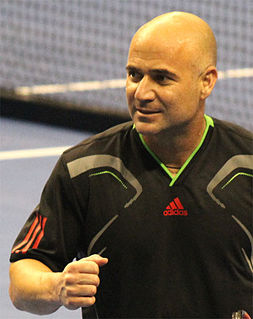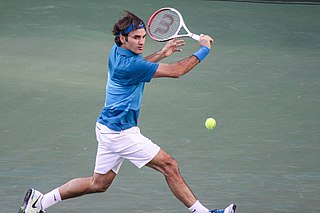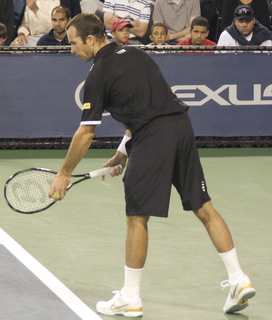
Andre Kirk Agassi is an American former world No. 1 tennis player. In singles, Agassi is an eight-time Grand Slam champion and a 1996 Olympic gold medalist, as well as a runner-up in seven other Grand Slam tournaments.

Björn Rune Borg is a Swedish former world No. 1 tennis player. Between 1974 and 1981, he became the first man in the Open Era to win 11 Grand Slam singles titles, but he never won the US Open despite four finals appearances. He is the first male player to win five Wimbledon titles in the Open Era.

Tennis is a racket sport that can be played individually against a single opponent (singles) or between two teams of two players each (doubles). Each player uses a tennis racket that is strung with cord to strike a hollow rubber ball covered with felt over or around a net and into the opponent's court. The object of the game is to manoeuvre the ball in such a way that the opponent is not able to play a valid return. The player who is unable to return the ball will not gain a point, while the opposite player will.

A racket or racquet is a sports implement consisting of a handled frame with an open hoop across which a network of strings or catgut is stretched tightly. It is used for striking a ball or shuttlecock in games such as squash, tennis, racquetball, rackets, badminton and padel. Collectively, these games are known as racket sports. Racket design and manufacturing has changed considerably over the centuries.

James Scott Connors is an American former world No. 1 tennis player. He held the top Association of Tennis Professionals (ATP) ranking for a then-record 160 consecutive weeks from 1974 to 1977 and a career total of 268 weeks. By virtue of his long and prolific career, Connors still holds three prominent Open Era men's singles records: 109 titles, 1,557 matches played, and 1,274 match wins. His titles include eight major singles titles, three year-end championships, and 17 Grand Prix Super Series titles. In 1974, he became the second man in the Open Era to win three major titles in a calendar year, and was not permitted to participate in the fourth, the French Open. In 1982, he won both Wimbledon and the US Open and is considered to be the unofficial No. 1 player for that year, in addition to 1974 and 1976. He retired in 1996 at the age of 43.

Adidas AG is a German multinational corporation, founded and headquartered in Herzogenaurach, Germany, that designs and manufactures shoes, clothing and accessories. It is the largest sportswear manufacturer in Europe, and the second largest in the world, after Nike. It is the holding company for the Adidas Group, which consists of the Reebok sportswear company, 8.33% of the German football club Bayern München, and Runtastic, an Austrian fitness technology company. Adidas' revenue for 2018 was listed at €21.915 billion.
Yonex Co., Ltd. is a Japanese sports equipment manufacturing company. Yonex produces equipment and apparel for tennis, badminton, golf, and running.
The Wilson Sporting Goods Company is an American sports equipment manufacturer based in Chicago, Illinois. From 1989 onward, it has been a subsidiary of the Finnish group Amer Sports, since 2019 itself a subsidiary of the Chinese group ANTA Sports. Wilson makes equipment for many sports, among them baseball, badminton, American football, basketball, fastpitch softball, golf, racquetball, soccer, squash, tennis, pickleball and volleyball.
Brian David Teacher is a former American professional male tennis player. He reached a career-high ranking World No. 7 in 1981.

Slazenger is an English sports equipment brand, currently owned by the Frasers Group since 2004. The original private company Slazenger had been established as a sporting goods shop in 1881. In 1959, the Slazenger family sold the company to Dunlop, which became Dunlop-Slazenger before it was sold to BTR plc. in 1985.
Howard Head was an aeronautical engineer who is credited with the invention of the first commercially successful aluminum laminate skis and the oversized tennis racket. Head founded the ski making firm Head in 1950. Later he became chairman of Prince Manufacturing Inc. The U.S. patents for the laminate skis and oversized tennis racket are in the name of Howard Head.

Prince Global Sports, LLC, is a US sporting goods manufacturing company based in Atlanta, Georgia. Founded in 1970, Range of products manufactured includes rackets, footwear, apparel, tennis balls, pickleball paddles, stringing machines, hats, bags, among other accessories.

The Wilson Pro Staff Original, first introduced in 1984 is most known for being the model of racket used by Pete Sampras. For this reason, it is known as a “Sampo”.
Head Sport GmbH is an Austrian manufacturing company headquartered in Kennelbach. It owns the American tennis racket brand Head. Head GmbH is a group that includes several previously independent companies, including the original "Head Ski Company" ; Tyrolia, an Austrian ski-equipment manufacturer; and Mares, an Italian manufacturer of diving equipment.
Dunlop Sport is a British sports equipment manufacturing company established in 1910 that focuses on racquet sports, more specifically tennis, squash, padel and badminton. Products by Dunlop Sport include rackets, strings, balls, shuttlecocks, and bags. Sportswear and clothing line includes t-shirts, shorts, skirts, jackets, pants, socks, caps, sneakers, and wristbands.
Since the sport's inception, the design and manufacture of tennis equipment has been affected by technological advances and regulations. As is common in major sports, regulations became more exacting over time, with improvements affecting the qualities of the tennis racket and the tennis ball.

Four wall paddleball, or paddleball, is a popular court sport in the Upper Midwest of the United States, on the West Coast of the U.S. and in the Memphis, Tennessee area. It is played with a paddle and small rubber ball on a standard handball or racquetball court, with similar rules to those sports.
Gosen Co., Ltd. is a Japanese company that produces synthetic strings for the fishing, manufacturing and racquet sport industries.

Bosworth Tennis, also known as Bosworth International, is a family business which specializes in stringing tennis rackets but also designs and alters other aspects of tennis rackets to match the personal preferences of the players. They have worked with many of the top tennis players, notably Ivan Lendl. The company was created by Warren Bosworth in 1975. By 1992 his business moved from Glastonbury, Connecticut to Boca Raton. It is now led by his son Jay Bosworth, who joined the company in 1982. It is one of a handful of highly specialized companies catering to the top professional players, compabarable to Roman Prokes and Nate Ferguson, but they also provide similar services to amateur players.
ProKennex is a Taiwanese manufacturer of racquet sports equipment for tennis, squash, badminton and racquetball. The company enjoyed wide global distribution in the 1980s, when manufacturing in Taiwan was booming due to domestic economic conditions. Parent company Kunnan Enterprise Ltd. has faced financial difficulties since the mid 1990s, leading to a contraction of the ProKennex name globally. Today, the company focuses on a niche set of consumers interested in technology advancements in racquet sports. The company focuses on this aspect of its products by promoting itself as a "science and design company", rather than a standard racket manufacturer.












